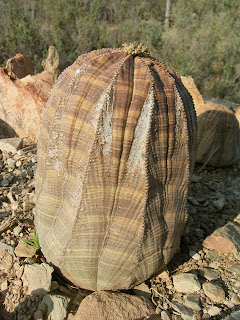Euphorbia obesa is distributed and uncommon in the arid areas of the Graaff-Reinet district in the Eastern Cape Province. The plants were discovered in 1897 by MacOwen near Kendrew south of Graaff-Reinet. Euphorbia obesa soon became one the most sought after Euphorbia species of all time and was unscrupulously collected in the wild for many years. Fortunately the plants are now protected and propagated from seed all over the world.
Its attractive almost rotund shape with eight segments resembles much the huts that some of the native people make and hence it was initially referred to as "Kafferhut" (Afr.). Nowadays this name has been abandoned and the plants are more happily called "Vetmensie" (fat-person).
Euphorbia obesa elongates out of its ball shape with age becoming somewhat columnar.
This is one example of convergence in evolution, where Euphorbia obesa has attained a similar shape and appearance than the totally unrelated cactus Astrophytum asterias.
The plants are unisexual and the female plants produce fairly large amounts of seed on the apex of the plant about twice per season. The peduncles are not persistent and fall off after the seed ripens.
In nature hybrids are sometimes formed with Euphorbia ferox.
Euphorbia obesa does well in cultivation. Avoid winter temperatures much below -3 deg. Celsius. The plants like full sun, heat and detest waterlogged soils. A well drained slightly sandy soil should be ideal.


Post a Comment